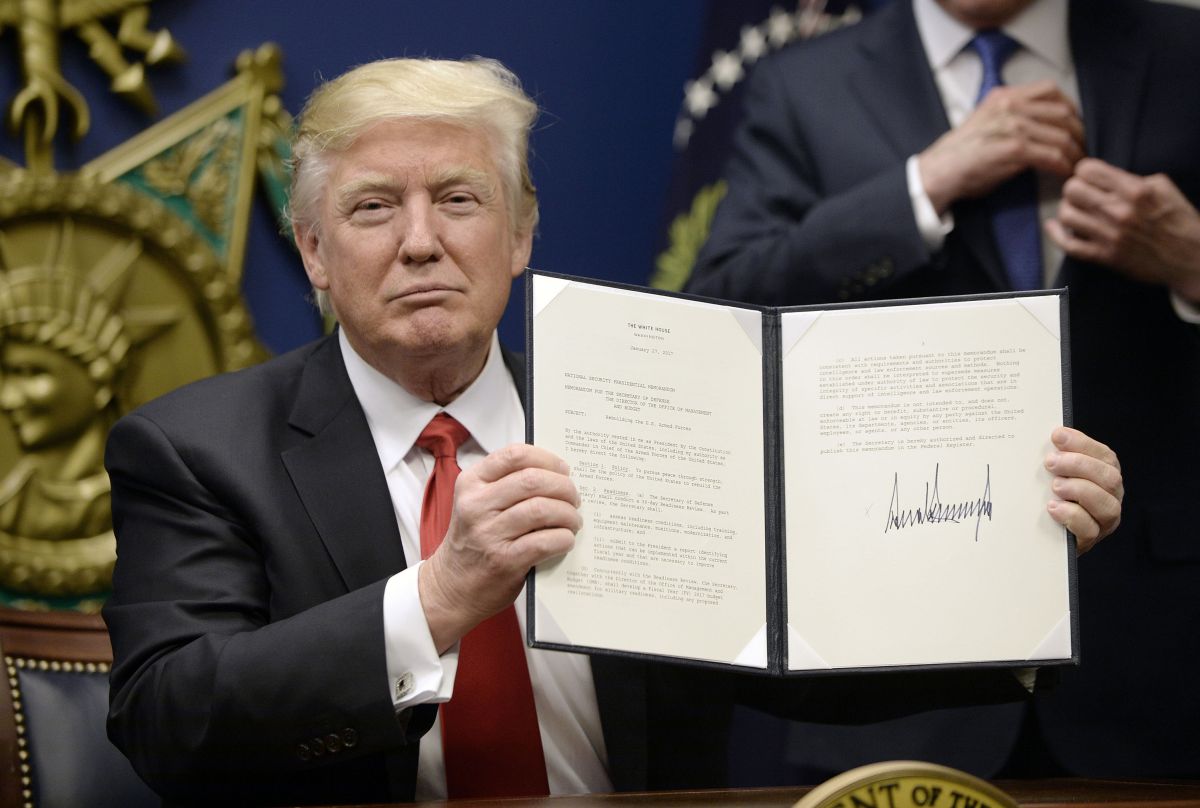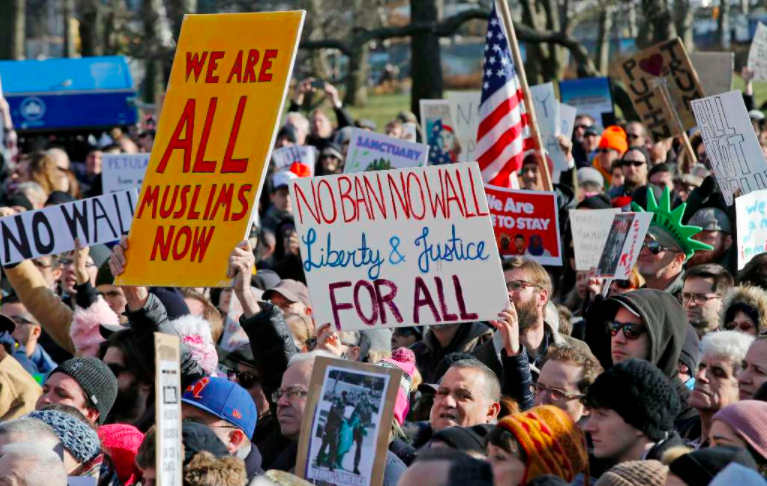So where is the pivot? No, not the Obama Administration’s Asian pivot. I’m speaking of another pivot. This one was to occur when candidate Trump transformed from candidate to President-elect and then to President. Some hoped, or rather convinced themselves and others, that the incendiary ‘rogue’ candidate would settle down and emerge as a more diplomatic, more traditional, President Trump. But the first weeks of President Trump administration have proven those hopes to be futile. As The Economist wrote: “To his critics, Mr. Trump is reckless and chaotic. Nowhere more so than in last week’s temporary ban on entry for citizens from seven Middle Eastern countries—drafted in secret, enacted in haste and unlikely to fulfil its declared aim of sparing America from terrorism.”

President Donald Trump signs Executive Orders in the Hall of Heroes at the Department of Defense Friday, Jan. 27, 2017 in Arlington, Va. (Olivier Douliery/Abaca Press/TNS)

Protesters and immigrants rights advocates gathered at Castle Clinton National Monument, the physical departure and arrival point for tours of the Statue of Liberty in New York City. (AP)
His first weeks have already been extraordinary and exhausting. While we concern ourselves with global governance and the liberal world order, Trump and his inner circle, including Steve Bannon, ‘the Darth Vader of the West Wing,’ or Michael Flynn, appear to be ready to ‘burn the order to the ground,’ asTom Wright at the Brookings Institution suggested several months ago. This appears to be a presidency built on a belief that nationalist, even populist prescriptions, are ‘just what the doctor ordered’ – at least for the United States.
Taken at its best, the high-strung foreign policy rhetoric of this President seems to echo the great Tom Schelling‘s tactical decision approach to nuclear deterrence in international relations. Schelling identified this strategy as the ‘rationality of irrationality’ and decades ago it was applied by some Presidential-watchers to then president Richard Nixon. The theory suggests appearing just a little crazy in order enhance your bargaining position with a competitor. However, the dilemma is that Trump is seemingly mostly targeting his friends, while being more nuanced when it comes to his perceived natural rivals, most notably Russia’s Putin. His praise appears to be saved for populists like the UKIP’s former leader Nigel Farage, or the current President of the Philippines. And there appears to be no rational objective in mind.
From where do these ideas emerge? Where has Trump adopted this notion that international relations is a zero-sum contest with friends and rivals alike? Certainly on trade and strategic alliances such as the WTO or NATO, you need go no further than Trump himself. For decades now, at least with respect to trade, he has thundered against bad multilateral trade deals. Repeatedly, Trump has condemned United States for entering agreements that damage the United States and drive American manufacturing jobs to Mexico and China. Trump has been quoted as condemning previous administrations for their readiness to aid others at the expense of the United States. “We’re taken advantage of by every nation in the world virtually,” he said on Thursday at a prayer breakfast. “It’s not going to happen anymore.” But there is even a darker side to his worldview. Some of his perspectives seem to owe their authorship directly to Steve Bannon, former executive chair of Breitbart News, a rightwing news, opinion, and commentary website, who is also Trump’s chief strategist. Many have suggested that the substance and rollout of the immigration executive order had Bannon’s involvement all over it. Among other things, Bannon has been supportive of the populist movements in European countries and has favored the end of the European Union. Trump has echoed these sentiments, marking a remarkable shift in U.S. policy. After decades of building multinational alliances as a guarantee of peace, the White House has now indicated it may purposely undermine these international institutions. Bannon, in his 2014 speech at the Vatican, cast this as a return to a better past:
I think strong countries and strong nationalist movements in countries make strong neighbors,” Bannon said. “And that is really the building blocks that built Western Europe and the United States, and I think it’s what can see us forward.
But this nationalist political approach seems so out of sorts with previous U.S. Presidents and their key advisors. American exceptionalism has always been an element of U.S. foreign policy thinking, but the architects of the liberal order saw that narrow nationalism and building walls led to rivalry, competition, and war. Cordell Hull, President Franklin D. Roosevelt’s long-serving secretary of state and a key architect of postwar foreign strategy, once wrote and was quoted recently by Eduardo Porter in the New York Times saying, “if we could increase commercial exchanges among nations over lowered trade and tariff barriers and remove unnatural obstructions to trade, we would go a long way toward eliminating war itself.” This is not a call for growing nationalisms.
So if Trump truly believes that the well-worn path trodden by previous Presidents since the end of World War II are misguided, where do we go from here? Stewart Patrick, from the Council of Foreign Relations has suggested a series of alternatives. As I pointed out in a recent post at Rising BRICSAM, there are, in his mind, five alternatives. Patrick has suggested that elements from all five are likely to be built into whatever alternative order emerges. Though greater U.S. isolation is possible, it is more likely that aggressive U.S. actions will dominate during a Trump Administration and so a nationalist great power architecture of some form is likely with or without alliances and international institutions.
What does this suggest for key bilateral relations say with Europe, Russia, or, most importantly, China? It was evident even before Trump that China occupied growing U.S. attention whether from the Clinton, Bush, or Obama administrations. All recognized the growing power of China internationally, and especially regionally. Notwithstanding tensions over the East and South China Seas and difficult and incomplete efforts to forge US-China cooperation in Korea, US-China agreements over Iran and climate change particularly have been foundational in moving these issues forward. Can this be continued in Trump’s far more competitive stance over trade and the One-China policy?
Jeffrey Bader, a former Obama official and currently a senior fellow at Brookings has identified options in a Brookings report that have the potential to reverse rising tensions US-China relations. Acknowledging the difficulty for President Xi Jinping and the other leadership figures facing the 19th Party Congress in initiating temperature-lowering bilateral policies, there is an immediate area of cooperation in trade and investment. There is no question that there are far too many barriers to foreigners in select, but key sectors, and too many barriers to imports. A willingness on the part of Chinese leadership to negotiate or renegotiate investment and trade provisions could ‘just be what the doctor ordered’ for the US-China relationship. Ultimately, proposals in trade and investment have the added benefit of advancing market reforms, which Xi has repeatedly supported and will likely continue to do so in the future.

